-----------------------------------------------------------------
Bjørn Wangen
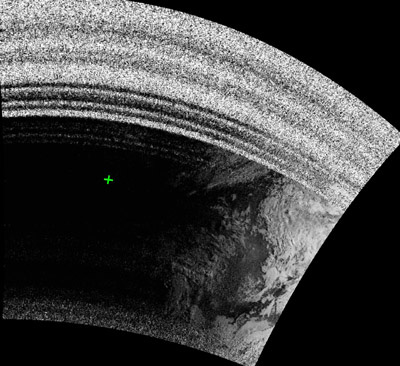
X – I am here: Antenna, radio/computer, looping slideshowprojection and sound.
This work is about being. If nobody recognises me, the satellite will.
This work is about being in the world. It is about landscape imagery, like the old romantic point of view; being in the landscape, or looking at the landscape. A simple cross points out my position. I am in the world. If nobody recognises me, the satellite will.
The antenna fetches weather report images fram passing satellites. The images are projected in a slideshow loop in a pulsating fashion. Old images are replaced by new ones as new satellites passes in the sky.
-----------------------------------------------------------------
Frank Fietzek & Uli Winters
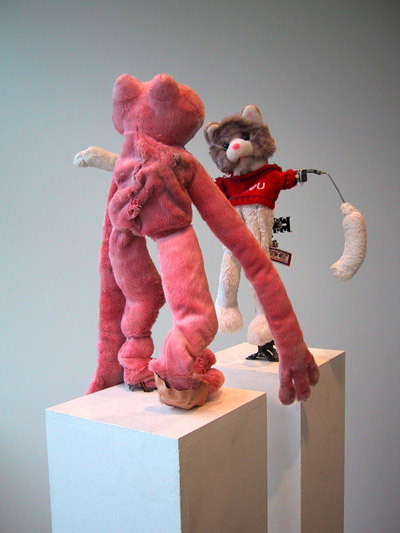 Watschendiskurs: Cat, Frog, controller, servo-motors, PC, pitch-bended soundfiles of recorded statements about language theory.
Watschendiskurs: Cat, Frog, controller, servo-motors, PC, pitch-bended soundfiles of recorded statements about language theory.
Words are one of the most powerful and at the same time one of the most feeble means of interaction. Being strictly human they are an exclusive privilege of mankind. Yet it is plain to see that words often create the problems they are supposed to solve in the first place. You can talk about everything which is at the same time very frightening and fascinating as it includes failure: You can also misunderstand anything and that can evoke various unpleasant effects from silly discussions up to world war III.
The two puppets of WATSCHENDISKURS ("Face-slapping discourse") are involved in a discussion about language theory. Like in many a real life discussion they pick their phrases randomly from a pool of more or less witty statements on the topic of language including Wittgenstein-Quotes and Russian weather proverbs. From time to time this discussion gets pretty emotional, and at a point where words no longer seem to be the right tool of convincing the other one, the frog and the cat lose their temper. A slap in the face stops the opponent and gives way for another intellectual excursus about the different layers of speech.
Shut up and listen!
---------------------------------------------------------------
Adam Somlai-Fischer, Bengt Sjölén, Danil Lundbäck
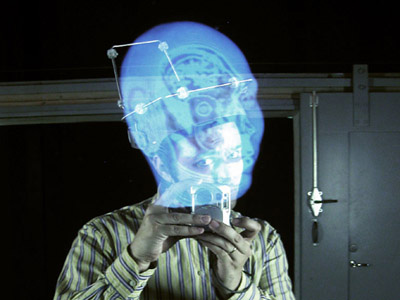
Brainmirror: Nautral Interaction
Brainmirror is an interactive experience where the image of the visitors brain appears mixed with his/her mirror image, using natural head movement as an interface to explore volumetric visuals of the human brain. It was developed to create an interface that works without learning for all age groups, that fosters communal interaction, interaction among the different visitors.
Natural Interaction
Many interactive information displays today require either the use of buttons, or standard computer interfaces. Our interaction thinking is focusing on creating a simple but powerful language for the visitors to explore the otherwise complex MRI brain data. Everybody, including Kids and elderly people can use the installation instantly without learning the interface.
Brainmirror is tracking the head movement, and displays generated brain models on a projection surface is 1 meter behind a half transparent mirror making the projection seem to float in the air 1 meter in front of the mirror.
The visitors can find models of brain lobes, sub cortical systems, pathways and centra of the brain with an information overlay pointing out different anatomical parts and describing their functionality, nd several volumetric renderings of MRI data.
Volumetric renderings are explored by moving closer to the mirror, using the mirror as a slicing plane. All modes grow as we move closer to the mirror, a natural actions by the visitors to see more details.
Our Technology:
Motiontracking
The motion tracker computer watches the audience through four fire-wire cameras equipped with infra-red filters. The helmets are mounted with super-bright infra-red LED's, each modulating it's brightness with it's own unique finger-print id-code.
Rendering
MRI volumetric images consist of a 3-dimensional volume of voxels each describing the hydrogen proton density in each position. Different tissues can be separated by their densities making different kinds of tissues clearly visible. MRI volumetric images is rendering using raycasting from each pixel of the screen through the volume, integrating attenuation along the path of the ray alternatively calculating gradients and shading the volume with light. Ray casting is done with fragment shaders on the GPU of the consumer graphics cards
-----------------------------------------------------------------
Pablo Miranda Carranza
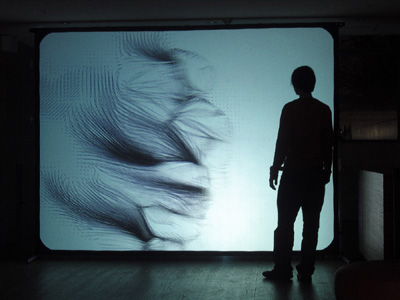
mv_alg_#09
mv_alg_#09 (machine vision algorithm #9) is a software piece which investigates how the traditional architectural space of the theatre is affected by interactive, computational media. If theatres have consisted of the division between cavea and stage, spectators and representation, a model present also in cinema theatres, interaction collapses both in to each other, the difference between actors and spectators is broken, and a new architectural space appears. In this particular case, a camera is pointed back from the screen on to the space, and the movement captured from the image is transformed and fed-back in to the actors/spectators. The idea is to activate architecturally a space by the use of algorithmically controlled graphic media; mv_alg_#09 uses a web cam and Computer Vision programs to achieve this. mv_alg_#09’s architectural and spatial qualities exist coded in software, which are experienced as the program is performed, deployed and actualised in dialog with any other physical place and space.
-----------------------------------------------------------------
Tine Bech
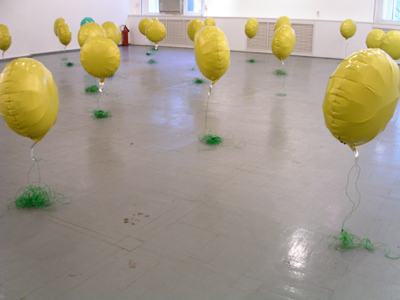
Floating Field
Floating Field is an interactive sound installation using movement from the audience to create sound. A sea of helium balloons is floating just above the floor, filling the room. The balloons move and sway when the viewer walks through and triggers a sound from the balloons. Lots of movement creates multiple sounds, when the viewer stands still the sounds fade away. The audience can thus create their own compositions.
Bech uses a range of everyday materials – balloons, tapioca,, sugar, felt, electronics etc. Her tactile materials are reminders of physicality - we want to touch her objects, we need to walk around them, to experience them, to meet them and they interact with us, responding to our proximity.
Her work speaks to the body (and a sense of humour). By using materials that relate to the body such as sound and interactive technology we are reminded of the role of the body in experiencing and understanding the world.
The body is the membrane through which we must necessarily relate to the world.
But the borderline between body and world is not sharply defined: instead they are entwined in a constant dialog. It is this dialog that creates the work.
Tine Bech was born in Denmark. She moved to London in 1997 to study for her MA Sculpture in 1997. She has exhibited her work in Denmark, Moscow, Berlin, the USA and England in venues including The RBS Gallery, L Gallery (Moscow), and Aarhus Kunstbygning and The Fort Collins Museum of Contemporary Art (USA). The work has been published in various magazines and newspapers and is mentioned in the book ‘Dansk Kunst 2003’ (Danish Art of the Year). Tine has collaborated with different scientists in creating interactive artwork. At the International Conference on Artificial Life (2002) a collaborative project was published in conjunction with Dr. Sam Woolf (Sussex University, Interact Lab). Tine was awarded a Royal British Society of Sculpture Bursary in 2004 and was subsequently mentioned in the article ‘The UK’s Sculptural Newcomers’ in the New York Magazine, NY Arts in 2005.
-----------------------------------------------------------------
Audun Eriksen
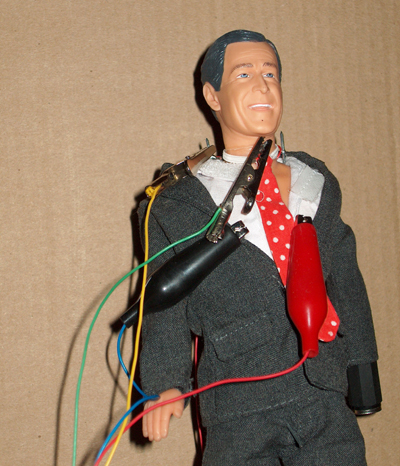
The piece ”Joystick Bush” consists of a commercial George Bush action figure with sound sampels from speaches, modified through so called circuit bending. The new functions in the action figure is controlled by the spectators through a joystick. The piece is taken from a concert preformed by John Hegre and Audun Eriksen at the opening of the exhibition Detox in Bergen Kunsthall in 2004.
Bush is approximately 25 cm tall. He has spikes sticking out here and there, with wires tied up with crocodile clips. The wires is connencted to the joystick. The joystick controles samples, loops and pitch.